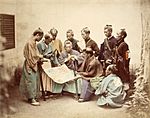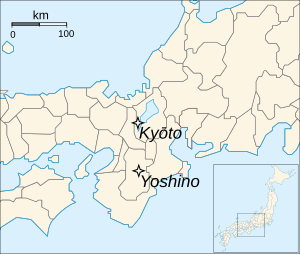Kōei facts for kids
 |
|---|
|
Kōei (康永) was a special time period in Japanese history. It was an Japanese era name (called nengō) used by the Northern Court. This was during a time known as the Era of Northern and Southern Courts. The Kōei era lasted from April 1342 to October 1345. During this time, the emperor in Kyoto was Emperor Kōmyō (光明天皇, Kōmyō-tennō). At the same time, the Southern Court had its own emperor, Emperor Go-Murakami (後村上天皇, Go-Murakami-tennō), who lived in Yoshino.
Contents
Understanding Japan's Two Courts
Imagine a time when Japan had two emperors at once! This happened during the Nanboku-chō period. One emperor ruled from Kyoto, and his court was called the Northern Court. The other emperor ruled from Yoshino, and his court was called the Southern Court.
For a long time, people weren't sure which court was the "real" one. But in 1911, a special rule was made. It said that the emperors of the Southern Court were the true rulers. This is because they had the special treasures of the Imperial family. These treasures are called the Imperial Regalia.
The Northern Court was set up in Kyoto by a powerful general named Ashikaga Takauji. Even though they had military power, they didn't have the Imperial Regalia.
How the Kōei Era Began
- 1342 Kōei gannen (康永元年): The name of the era was changed to Kōei. This happened to mark important events. The previous era, called Ryakuō, ended in its fifth year, and the new Kōei era began.
While the Northern Court used the Kōei era name, the Southern Court used a different era name. Their era was called Kōkoku, which lasted from 1340 to 1346.
Key Events During the Kōei Era
During the Kōei era, several important changes happened in the government. These changes mostly involved powerful leaders taking on new roles or leaving their positions.
- 1342 (Kōei 1, 1st month): Ichijō Tsunemichi lost his job as kampaku. This was a very high position, like a chief advisor to the emperor. He was replaced by Kujō Michinori.
- 1342 (Kōei 1, 2nd month): Minamoto no Nagamichi (源長通) was removed from his position as daijō daijin. This was another very important government role.
- 1342 (Kōei 1, 11th month): Kujō Michinori, who had just become kampaku, was replaced. His replacement was Takatsukasa Morohira. Morohira had previously held the position of udaijin.
- 1342 (Kōei 1, 12th month): Fujiwara no Kiyoko passed away. She was the mother of Ashikaga Takauji, the general who started the Northern Court.
- 1343 (Kōei 2, 4th month): Nijō Yoshimoto was promoted. He was an important writer who wrote a book called Masukagami. He moved up from nadaijin to udaijin. Later, he was promoted again to sadaijin. Another official, the dainagon, was also promoted to nadaijin.
- 1344 (Kōei 3, 1st month): Shōgun Takauji, the powerful military leader, visited Iwashimizu Hachiman-gū. This was a shrine where he offered prayers.
See also
 In Spanish: Kōei para niños
In Spanish: Kōei para niños


